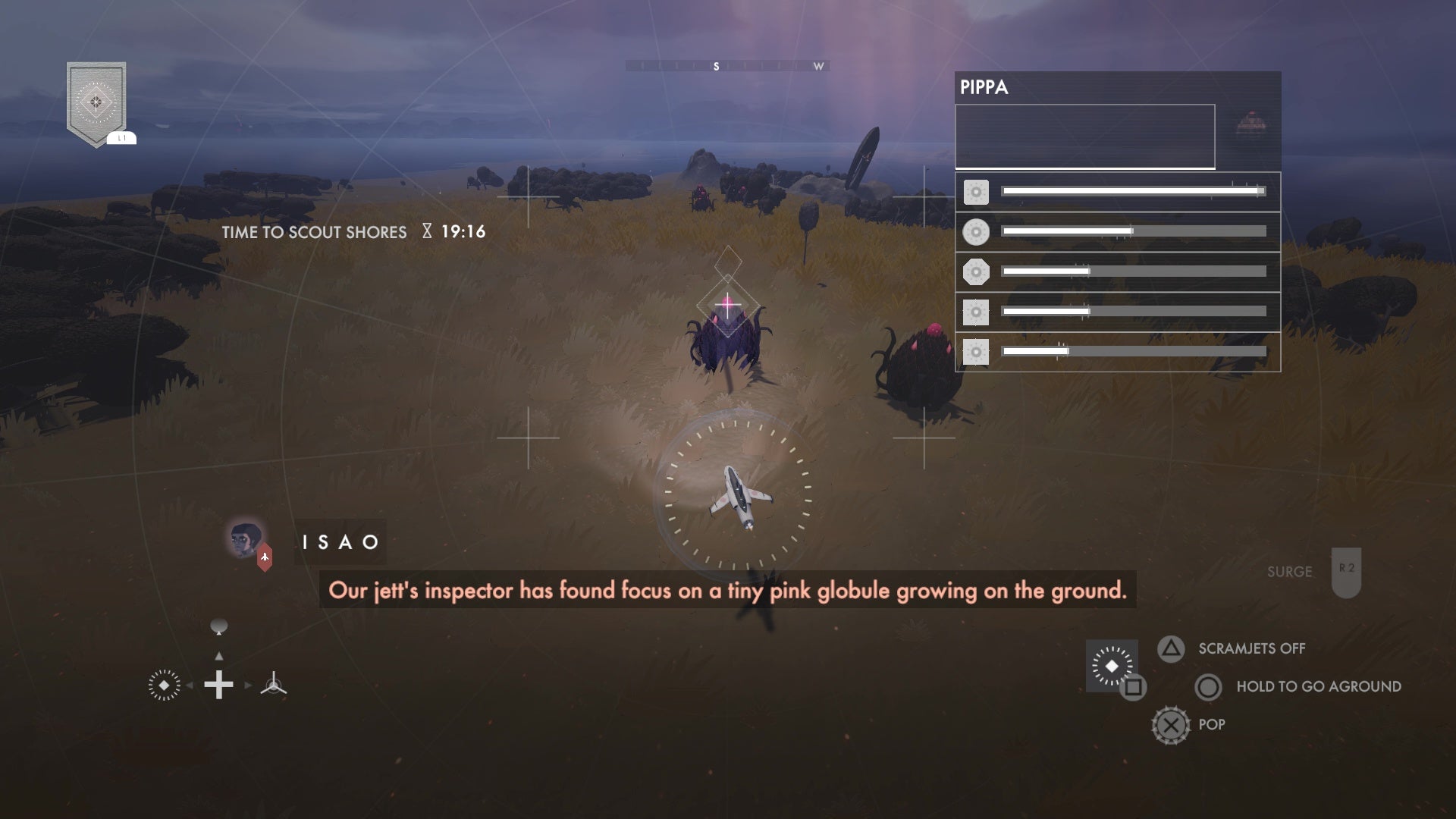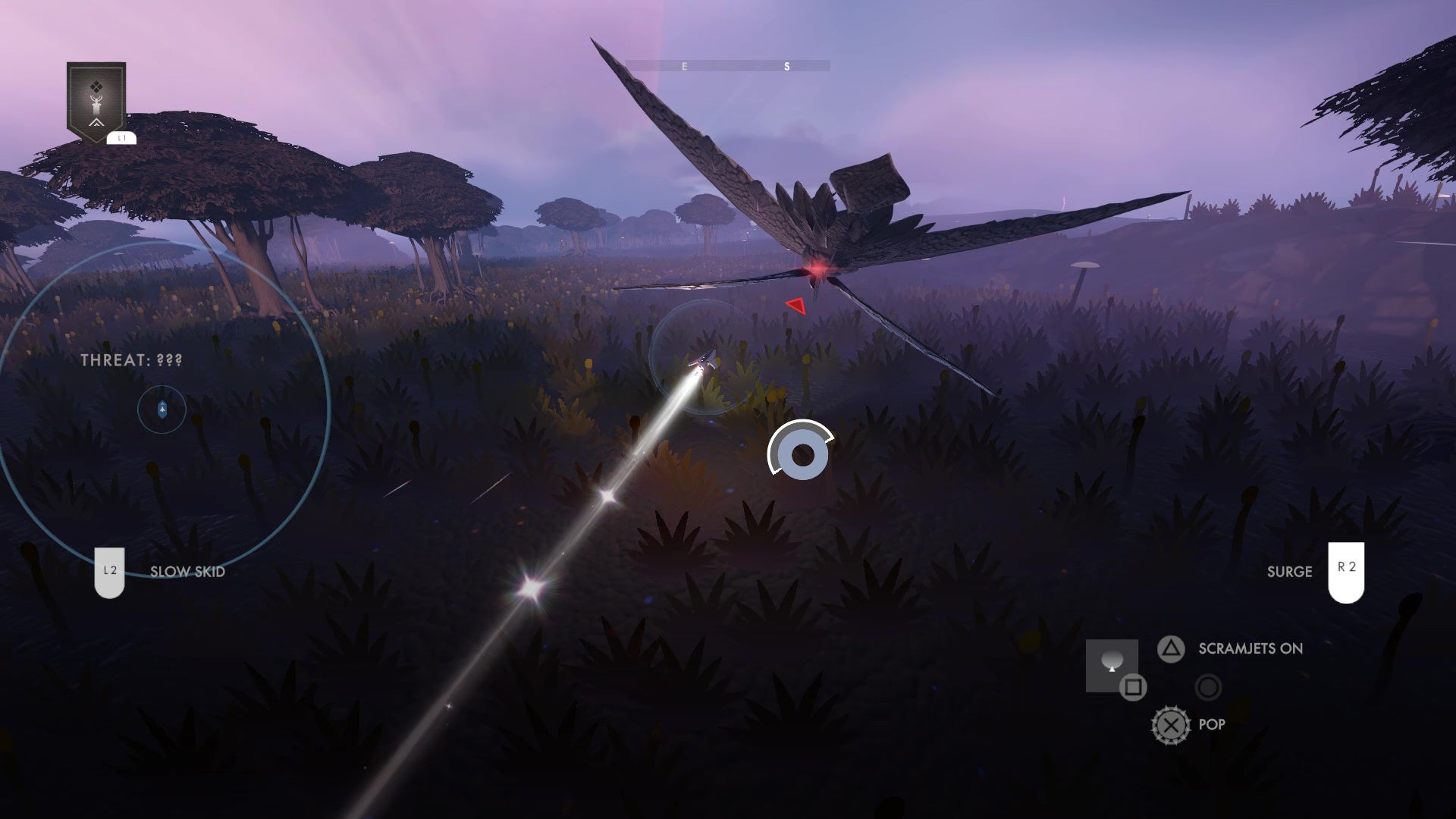Jett: The Far Shore has this tantalising premise. You play as a scout and “Anchorite” called Mei, who’s been chosen by her community to explore this mythical ocean planet. Anchorites believe that this watery globe is home to the sacred “Hymnwave”, a sound so delightful it promises sanctuary from impending oblivion. So you leave your folks behind, strap into your jett ship, and set off in search of this heavenly tune. This isn’t a solo venture, but one where you’re joined by a small group of fellow scouts. Having only played the first few chapters so far, it’s difficult to know just how much you’ll get to know them over the course of the game, but my interactions have been a mix of chats over an intercom, and some in-person natters on land. All of which were pleasant enough, although I’m yet to break through their collective obsession with the Hymnwave and uncover some individuality. I’m confident this will come with time, as I do get this feeling that they’re slowly warming to my presence. I also hope to learn more about Isao, a calm fella who helps you get up to speed with your ship as you land on the titular Far Shore planet’s vast ocean surface. Thank god he’s so patient, as there’s a lot to take in. Having already showed you the ropes of how to pilot your ship back on your homeworld, Isao has more to teach you when you touch down and begin your journey to a place called Scout’s Prospect, an enormous, pyramid like structure that pierces the sky in the distance. Among them is how to scan things with your resonator, turn your flashlight on, and balance your boosts to speed over the water’s surface without overheating. I really enjoyed this last bit, as there’s something rather relaxing about skating over the waves as the camera zooms out and Scntfc’s sweeping music kicks in. When Jett: The Far Shore makes it feel like you’re skimming through a prog-rock album it’s a proper delight. Not so much when you need to slow down, though; at least not yet. When you hit your first land mass, one of your earliest tasks is to survey it using your ship’s three main tools: the flashlight, the scanner, and a grappling hook. With the camera pulled out and your ship a tiny spec onscreen, you essentiallly buzz around like a flying scientist, using them on any vegetation or creatures you come across and seeing how they react. Did chucking that glob of yellow gunk on that alien moose make it pass out? Good, that’s some data! For what, though, I’m not entirely sure yet. Perhaps this knowledge will come into its own later down the line, but early on it’s just a means of pushing the story forwards. Maybe it’s the game attempting to immerse you in its world, but this lack of purpose and direction towards gathering data gathering left me a bit cold. I don’t think its slightly finicky controls helped, either. Your ship feels built for long arcs across the water, not for precision hovers over terrain. So often I’d get tangled in some overgrowth, or snag on a rock, or curse my woeful turning circle. Controlling your ship is a dream when you’re in flow, but when you’re forced to disrupt this rhythm it can quickly tip over into frustration. Some discoveries in Jett: The Far Shore are immediately more useful, though, purely because they help you keep the momentum going. Pass through little sparkles on water, or land, and they’ll reset your boosters, letting you go at max speed without needing to take your foot off the gas. “Pop” your jets on these large plant bulbs called Ghokeblooms and they’ll spring you up to new heights. Do the same on pools of blue water and they’ll replenish your shields. And a number of these things come in handy in Jett: The Far Shore’s non-sciencey bits - the bits I’ve enjoyed the most in the game’s early hours. At one point you’re darting between trees to escape from these pterodactyl-like space wasps and it’s a proper thrill ride. You need to barrel roll to prevent them from puncturing your little vessel and lay low in the canopy to throw them off the scent. I also think the game’s tendency to perspective shift plays a big part in making these action sequences more engaging. In the space wasp saga, at least, the camera zooms in a touch to highlight your ship, the fauna, and the raging creatures wanting to tear you to shreds. It’s a small touch, but it really adds to the intensity of the whole thing. Later, when you encounter a huge Kolos (a cross between Matilda the house robot from Robot Wars, a battleship, and a plane) the camera zooms out to take in the enormous beast, not only highlighting just how massive it is, but how puny you are in comparison. These moments are pretty epic on a big screen, but let me tell you, I actually really dig Jett: The Far Shore when it’s zoomed in nice and close. I like how the details of the planet’s surface pop a bit more and stir with life, as opposed to the more basic polygons you get when zooming around otherwise. This feeling kicks in a bunch when you get out of your ship too, as the ocean planet’s haze, or swaying mushrooms, or purple vistas smack you right in the visor the moment your feet touch ground. So far I haven’t been able to get out of my ship unless it’s for a story objective and even then I’ve been restricted to a small, circular space, but I hope there are more of these moments to come further along in the game. In your scout’s base it’s a different story. It’s hard to tell how often I’ll be heading back there throughout the campaign, but you can wander its safe corridors, chat with your comrades, and sleep in your cabin to save the game. I even shared a nice bowl of soup with everyone to celebrate something they called “Tsoultide”. Might carry that on in real life, to be honest. As I look back on my time with Jett: The Far Shore so far, my thoughts mirror the roaring ocean beneath Mei’s tiny ship. They veer wildly between, “Good, yes, I quite like this smooth ride,” and, “Lovely to look at,” to, “Hmmm, actually this isn’t quite as exciting as I’d hoped”. I have a feeling it’s going to be a slowburner, and I have to admit that it’s not fully gripped me yet. I’m hoping that the knowledge I’ve gained from surveying creatures will eventually pay off later on, and if it can strike that balance between the kind of scale and curiosity of a No Man’s Sky and the intimate, soothing exploration of In Other Waters, then I’ll welcome the Hymnwave with open arms.


